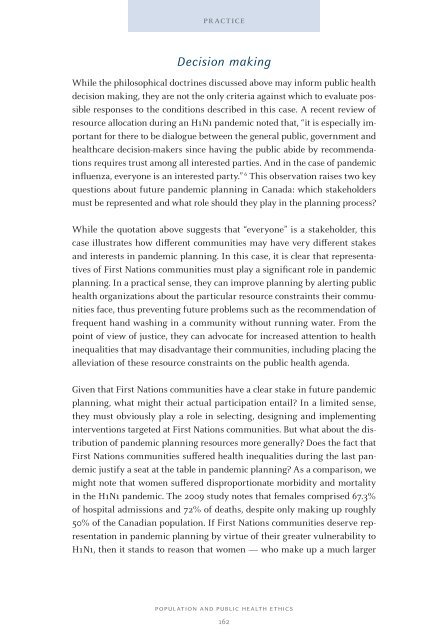PoPulationand Public HealtH etHics
PoPulationand Public HealtH etHics
PoPulationand Public HealtH etHics
You also want an ePaper? Increase the reach of your titles
YUMPU automatically turns print PDFs into web optimized ePapers that Google loves.
practice<br />
Decision making<br />
While the philosophical doctrines discussed above may inform public health<br />
decision making, they are not the only criteria against which to evaluate possible<br />
responses to the conditions described in this case. A recent review of<br />
resource allocation during an H1N1 pandemic noted that, “it is especially important<br />
for there to be dialogue between the general public, government and<br />
healthcare decision-makers since having the public abide by recommendations<br />
requires trust among all interested parties. And in the case of pandemic<br />
influenza, everyone is an interested party.” 6 This observation raises two key<br />
questions about future pandemic planning in Canada: which stakeholders<br />
must be represented and what role should they play in the planning process?<br />
While the quotation above suggests that “everyone” is a stakeholder, this<br />
case illustrates how different communities may have very different stakes<br />
and interests in pandemic planning. In this case, it is clear that representatives<br />
of First Nations communities must play a significant role in pandemic<br />
planning. In a practical sense, they can improve planning by alerting public<br />
health organizations about the particular resource constraints their communities<br />
face, thus preventing future problems such as the recommendation of<br />
frequent hand washing in a community without running water. From the<br />
point of view of justice, they can advocate for increased attention to health<br />
inequalities that may disadvantage their communities, including placing the<br />
alleviation of these resource constraints on the public health agenda.<br />
Given that First Nations communities have a clear stake in future pandemic<br />
planning, what might their actual participation entail? In a limited sense,<br />
they must obviously play a role in selecting, designing and implementing<br />
interventions targeted at First Nations communities. But what about the distribution<br />
of pandemic planning resources more generally? Does the fact that<br />
First Nations communities suffered health inequalities during the last pandemic<br />
justify a seat at the table in pandemic planning? As a comparison, we<br />
might note that women suffered disproportionate morbidity and mortality<br />
in the H1N1 pandemic. The 2009 study notes that females comprised 67.3%<br />
of hospital admissions and 72% of deaths, despite only making up roughly<br />
50% of the Canadian population. If First Nations communities deserve representation<br />
in pandemic planning by virtue of their greater vulnerability to<br />
H1N1, then it stands to reason that women — who make up a much larger<br />
PoPulation anD <strong>Public</strong> <strong>HealtH</strong> <strong>etHics</strong><br />
162
















